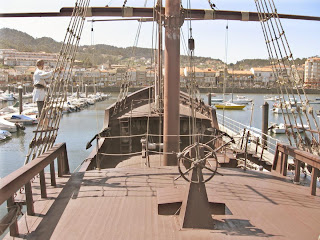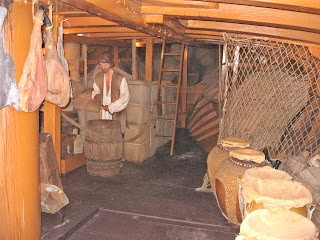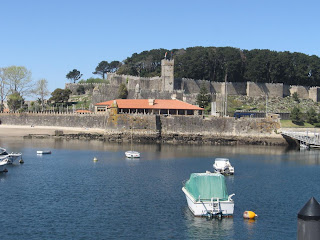Saturday 28th March 2009, Caminha, Portugal
We moved off the site mid morning yesterday after making the most of the campsite wifi to answer emails from friends and researchers. We parked on the edge of Baiona (Bayonna), a very pleasant little town of 10,000+ inhabitants. Much of the rest of the day was spent wandering the streets of the town in the warm sunshine, eating cod empanadillas on the sandy beach with stunning views across the marina to the eucalyptus clad, grey granite hillside further round the coast, and several off-shore islands.
The town's great claim to fame is that it was the first place to learn of the discovery of the New World. One of Columbus's ships, captained by Martin Pinzón, struggled into harbour here in 1493, its rigging in tatters, bringing with it the good news. There is a replica of the caravel, the Pinta, moored in the marina and a statue of Pinzón on the sea front.

For a euro each we did the touristy thing and clambered about on the Pinta. It is frighteningly tiny when you realise it crossed the uncharted waters of the Atlantic with no knowledge as to whether they would ever reach land. They carried everything with them and the crew slept on the decks. The ship had models of essential crew members but in reality there would have been far more people, plus all the food and water they required. We need to be incredibly tidy and organised in Modestine, how much more so on a ship with rigging, sails, foodstuffs, weapons, tools and cooking space with no possibility to restock during the voyage! There was a carpenter's workshop, the wheelhouse, the kitchen area and the hold. Here there was an exhibition of some of the things they may have carried back from the New World, including parrots, an alligator, guinea pigs, gold treasure, tomatoes, tobacco leaves, sweet corn, potatoes and even a couple of native Indians.




In the kitchen area were typical foodstuffs that would have been taken for the voyage. These included tightly packed barrels of sardines, dried salted cod, smoked legs of ham and sacks of grain, chestnuts and figs.
Back on dry land we explored the old town centre, a network of shady granite alleyways sheltered from the breeze of the bay. There was the usual collection of souvenir shops, cafes, bars and restaurants, but higher up there were cats and old ladies sunning themselves on their doorsteps surrounded by potted plants and it all looked very peaceful and pleasant.
In the central square we found the 18th century granite town hall. Inside there were a couple of models of caravels and upstairs an exquisite 17th century painted cupboard, several carved wooden chests and seats and a charter given to the town by Philip II in 1590.



During the afternoon we visited the huge, heavily restored but magnificent fortress on the headland at the far end of the town. Since the 1960s this has been used as a Parador (state run luxury hotel.) While the Parador accommodation is of recent construction – though well in style with the fortress - the ramparts, towers and gateways are original. We walked the couple of kilometres of ramparts around the fortress. They offer sublime, if windy views out to sea, to the islands, the distant mountains of Northern Portugal, and along the rugged coastline fringed with deserted beaches of soft, clean sand.







Finally we wandered into the Parador, explored its several lounges and bars, its warm, enclosed, cloistered courtyard with its central fountain, sat on several heavily plumped-up Spanish armchairs and finally selected a couple with views out to sea across the sunny terrace. Here we were served a couple of coffees which arrived accompanied by little tablets of sweet almond halva. No way could we ever afford the several hundred pounds a night for a room, plus sixty pounds each extra for meals, but this little taste of luxury cost us just five euros! We've tried several Paradors throughout Spain and the experience has always given great delight.



We moved on from Baiona during the late afternoon. Ian had been checking Google maps and declared that the next headland showed very little sign of development so we might get better sea views. He was quite right. We followed the coast along an almost empty road, passing through a few rural hamlets and eucalyptus forests. Otherwise we had fairly uninterrupted views down onto the breakers surging onto the rocks to our right, and steep, grey, scrub-covered hills rising to our left. Eventually we reached the little town of A Guarda, the last in Spain. Here we were brought up short by the estuary of the river Minho. Across the water lay Portugal and the delightful little town of Caminha which we had chanced upon as we travelled north, homewards, back in the winter of 2006. A small car ferry groans its way across whenever there are as many as four vehicles waiting. They welcomed Modestine aboard as vehicle number two and within twenty minutes another two had turned up. As we pulled away from the quayside yet another vehicle arrived, frantically skidding to a halt and hooting! The ferry went into reverse, the water swirled around us and we reversed slowly back to pick up the late arrival! It may be no coincidence that the ferry is Portuguese operated and the late-comer was Portuguese!


Modestine is something of a ferry junky and is thinking of writing her memoirs of ferries she has used. They must run into dozens by now. This though, at four euros for the three of us, is the cheapest international ferry crossing she has ever made! We watched Caminha approaching, recognising its main features. Within minutes of landing we remembered places we had visited and found our way directly to this campsite, sheltering, rather ineffectually, from the estuary winds behind sand dunes covered with pines and mimosa.


Later Saturday evening
The wind has been whipping in from the sea and the Minho estuary all day, stirring up flurries of sand around the campsite and coating everywhere in a fine film of yellow pollen. This latter is all pervading and comes from the pine trees all along this coast as well as the mimosa and even the palm trees that are currently producing huge bunches of yellow blossoms. It collects between the paving stones in the streets, it coats the surface of the sea in harbours, it gets into your clothes and into your lungs. It makes you wheeze and even makes your skin itch!
Today a group of excited young of Portuguese scouts arrived on the site for the weekend and pitched their tents nearby. They have been really well behaved and take their scouting duties very seriously. We saw them later around the town, carrying banners and stopping people with a questionnaire.


Last night we were too tired to work so spent the evening watching a DVD. The price we paid was spending this morning catching up on processing photos and adding them to the blogsite – the campsite here has free wifi! It's becoming far more prevalent than it used to be.
During the morning an English lady knocked on Modestine's door for a chat. Later they invited us into their camping car and as they are on their way from Portugal into Spain we swapped details of suitable camping sites for onward travel.
After lunch we went into Caminha which we found to be as lovely and as friendly as it had been when we first discovered it. See entry for 21st February 2006 The streets were familiar and on the central square with its large granite fountain there were hardy Portuguese families sitting out in the sunny breeze enjoying coffees and cakes.

In the town we discovered several streets and buildings that had previously escaped us. We even found the museum open! Hours do seem more civilised here than in Spain. The collections concentrated on local Celtic sites – dolmens, hut circles, tools and ceramics. There was an additional exhibition on the Peninsula War with Portuguese caricatures of Napoleon very similar to those prevalent in England at the time. We were probably the only visitors all afternoon and everything was written in Portuguese so we only had a vague understanding of the text. However, although Spanish and Portuguese sound completely different to our ears, the written language looks so similar, with obvious and consistent differences, that it must surely be possible for each to understand the other. Even we could grasp some meaning from the newspapers available at every pasteleria or coffee shop.

Peeping in at an open door, thinking it was the entrance to a church, we were almost physically dragged inside by a nun who slammed the door shut with us on the inside. She then proceeded to show us around the convent, explaining the pictures in the ceramic tiles on the walls, taking us into the chapel where she pointed out the different saints, showed us the carvings on the 17th century massive wooden doors and explained that the nuns were buried beneath the floor when they died which was why the church floor was a grid of granite stone with wooden covers fitting into each frame! She showed us the children's playground the convent has set up in its cloisters. She even gave us a potted history of the Franciscan order and told us that St. Anthony of Padua, whose portrait was in the church, had been born in Lisbon. She also told us about the appearance of the Virgin at Fatima, a famed Portuguese site of pilgrimage. As all this was done in Portuguese we reckon we deserve gold stars for working so much of it out. Maybe she thought all British stand around looking gormless and muttering "obrigado", hopefully eyeing the exit door whenever there's a pause in the conversation. Or maybe she just thought we were gormless, as not once did she even ask where we came from. What she did manage to make perfectly clear though, was that there was plenty more she could tell us about the Catholic saints before she'd release us unless we cared to make a donation to the convent! We dutifully emptied our purse and were rewarded by the sound of the key turning in the lock of the huge, carved, four centuries old convent door, releasing us back into the world.

We wandered back down to the town still feeling rather bemused by the experience and vowing never to stick our noses inside interesting doorways again. Discovering the pasteleria where we'd stopped on our last visit we went inside for coffee and a couple of interesting looking cakes. We have to say the bill was really cheap – much cheaper than a guided tour of a convent – but then the quality of the cakes was abysmal! They looked good but were tasteless and dry. The shop had stacks of them left for sale yet they tasted as if they'd been hanging around since our last visit, three years ago!
But the town is so nice, and the people are so friendly and helpful, that nothing could dampen our enthusiasm and we returned this evening to the campsite very satisfied with our restful and happy day. It's cold and dark outside now and the only sounds are the wind in the trees and the squawks of the little scouts getting themselves prepared for an exciting night in their tents.
Sunday 29th March 2009, Caminha, Portugal
Portugal keeps the same hours as Britain which means it runs an hour behind Spanish time. Last night they altered the clocks, just you did in England. So too did Spain. It is becoming totally confusing as we cross between borders and there isn't time to reset our watches before they need changing again! And every time we cross a bridge over the river Minho we feel like time travellers, arriving either 58 minutes before we started or finding it has taken almost an hour to travel a few hundred yards at 50 miles an hour! Generally though, Portugal seems to have shops and public buildings open at far more civilised hours than we found in Spain and places don't seem to shut for hours during the afternoon.
This morning we festooned our pitch with laundry. The wind blowing off the river estuary had it dancing around enthusiastically and we soon had duvet covers and towels back in active use without the necessity of rummaging around in coffers wondering where we'd packed the clean pillow cases and tea towels. In the meantime, we sorted out several problems using the campsite wifi, so by the time we were ready to go anywhere it was already early afternoon. So we decided to stay an extra day. When you find a nice site, why not linger? We went for a fairly local drive up the Portuguese side of the Minho river to the town of Valença, built inside a granite fort very much modelled on those of Vauban.

Valença is a colourful, picturesque old town full of quaint alleyways and little shops. These seem to exist solely for the Spanish who cross the river to spend the afternoon browsing the countless shops selling baby clothes, towels, table linen, Portuguese ceramics and cooking pots. Prices are thought to be very much cheaper than in Spain. Personally we though you could do just as well for price and quality using IKEA but it makes a pleasant afternoon out for the family.

We didn't realise until we arrived that the town had its holy procession this afternoon so we hung around for a couple of hours waiting for it to start. Around the streets, on corners and in front of churches, were tableaux of various saints, all wearing colourful silk and velvet clothes and curly wigs, surrounded by flowers. It's the run-up to Easter and the celebrations of Holy Week. Next week it's Spain's turn in the town of Tui on the opposite bank of the river, so we assume the parades are deliberately staggered so each town can cross to the other country to take part.




Having explored the fortifications, the churches, the shops and the museum, we stopped for a coffee in one of the cafeterias, crowded with families, waiting for the fun to begin. The local band marched down the street to the main church from where the procession was to start. We followed on. As we waited outside the church, ecclesiastical dignitaries in purple regalia came out onto the steps, followed by a couple of huge, purple banners. These were followed by a bier bearing a life-size statue of Christ. He carried a cross and was surrounded by flowers. The bier was obviously heavy and they had difficulty getting it down the church steps. Children and young people, dressed as angels, roman soldiers or characters from the Bible followed the bier through the streets and the procession was followed by the band, beating out the steps on a drum. The streets were crowded with onlookers but we managed to slip down a side street and reappear further along the route, thus seeing the procession pass twice. That was enough and we headed back to Modestine for the drive back to Caminha.




On the way "home" we stopped at the small town of Vila Nova de Cerveira. From the road it looked a typical, uninspiring town of flats faced with Portuguese tiles with various factory outlets, garages, supermarkets and furniture stores along the roadside. Immediately behind though, on the banks of the river Minho, we discovered a solidly built 17th century fortress, built to defend the town from the Spanish. The town was originally established by King Denis of Portugal in 1321 but largely rebuilt in the 17th century. We walked through the old town gates and climbed the steep streets up onto the fortress walls. From here there were excellent views across the river to the green, wooded hills of Spain, while surrounding the town on the Portuguese side were dry, arid hillsides scattered with golden gorse.

Just as we returned to the campsite, the English couple we spoke to yesterday stopped by to invite us to their camper van for a glass of wine. Modestine is far too small for entertaining so we happily accepted and spent a very pleasant hour sampling various Portuguese wines as we exchanged travellers' tales of incidents encountered in our various travels. It's quite fascinating to learn of the different reasons that lead people to spend their retirement years travelling around Europe. We are certainly not the only ones, though so far we've not met anyone who has travelled for so long in a vehicle anywhere near as small as Modestine!

